

A Gene-Editing Experiment on Human Embryos Went Horribly Wrong. According to a troubling scoop by OneZero, a team of London-based scientists used the popular gene-editing technique CRISPR to genetically modify human embryos — with deeply alarming results.
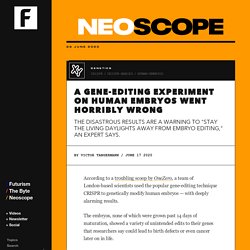
The embryos, none of which were grown past 14 days of maturation, showed a variety of unintended edits to their genes that researchers say could lead to birth defects or even cancer later on in life. “There’s no sugarcoating this,” Fyodor Urnov, professor of molecular and cell biology at the University of California, Berkeley, who was not involved in the research, told OneZero. Crispr'd Cells Show Promise in First US Human Safety Trial. New, super-precise CRISPR system could tackle a plethora of genetic diseases. A new method for gene editing, called prime editing, offers greater control over modifications and could be safer for use in humans than the widely popular CRISPR-Cas9 system.
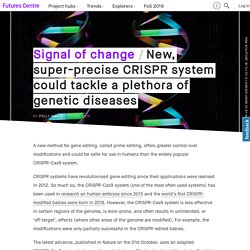
CRISPR systems have revolutionised gene editing since their applications were realised in 2012. A New Crispr Technique Could Fix Almost All Genetic Diseases. Chinese Scientists Say They’ve Found a Safer Alternative to CRISPR. CRISPR Competitor Researchers from China’s Peking University have developed a new gene-editing technology — and they think it shows promise as a CRISPR alternative for fighting human diseases.

According to a paper published on Monday in the journal Nature Biotechnology, this new technology, LEAPER, which stands for “leveraging endogenous ADAR for programmable editing of RNA,” works similarly to CRISPR-Cas13, targeting RNA molecules as opposed to DNA like the well-known CRISPR-Cas9. But while CRISPR-Cas13 relies on both a guide RNA and the Cas13 enzyme to make its edits to RNA, the LEAPER system needs just one component known as an arRNA. This makes the system “more easily deliverable and less likely to result in unwanted cellular immune responses,” the researchers told China-based media outlet Caixin.
Disease Destroyer. Exclusive: Five couples lined up for CRISPR babies to avoid deafness. By Michael Le Page Five Russian couples who are deaf want to try the CRISPR gene-editing technique so they can have a biological child who can hear, biologist Denis Rebrikov has told New Scientist.
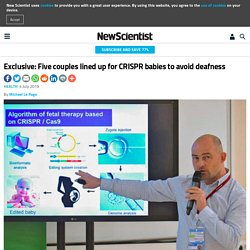
He plans to apply to the relevant Russian authorities for permission in “a couple of weeks”. The case for using CRISPR for this purpose is stronger than for trying to make children HIV-resistant, as attempted previously, but the risks still outweigh the benefits, say other researchers. “Rebrikov is definitely determined to do some germline gene editing, and I think we should take him very seriously,” says CRISPR expert Gaetan Burgio at the Australian National University.
“But it’s too early, it’s too risky.” Both would-be parents in each couple have a recessive form of deafness, meaning that all their children would normally inherit the same condition. CRISPR Helps Scientists Cure HIV In Living Animals For First Time. One-Two Combo For the first time, researchers have eliminated HIV, the virus that causes AIDS, from the genomes of living animals — a major accomplishment along the path to freeing the world of this deadly disease.
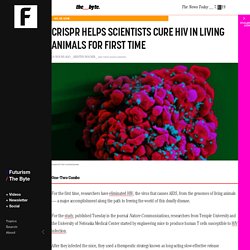
For the study, published Tuesday in the journal Nature Communications, researchers from Temple University and the University of Nebraska Medical Center started by engineering mice to produce human T cells susceptible to HIV infection. After they infected the mice, they used a therapeutic strategy known as long-acting slow-effective release antiretroviral therapy (LASER ART) to suppress HIV replication within the animals. Finally, the researchers used CRISPR to remove HIV DNA from the infected cells.
From Mice to Humans When the researchers later analyzed the mice, they found that about one-third of the animals showed no signs of HIV. Astronauts Use CRISPR in Space for the First Time Ever. Scientists Gene-Hack Viruses to Hunt and Kill Super-Strong Bacteria. New Anti-CRISPR Drugs Could Prevent Creation of Killer Plagues. Beyond Cas9: 4 Ways to Edit DNA. Tiny New CRISPR Protein Could Make Human Gene-Hacking Less Risky. Another Scientist Is Gene-Editing Human Embryos — but More Ethically. A Better Way Not all human gene-editing research is created equal.
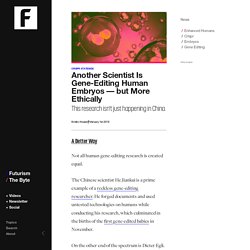
The Chinese scientist He Jiankui is a prime example of a reckless gene-editing researcher. He forged documents and used untested technologies on humans while conducting his research, which culminated in the births of the first gene-edited babies in November. On the other end of the spectrum is Dieter Egli. On Friday, NPR published a story revealing that the Columbia University biologist is conducting his own human gene-editing research — but rather than endanger human lives, like He’s research did, Egli’s could help save them. Guangdong releases preliminary investigation result of gene-edited babies. GUANGZHOU, Jan. 21 (Xinhua) -- A preliminary investigation into the claimed "genetically edited babies" shows that Chinese researcher He Jiankui had defied government bans and conducted the research in the pursuit of personal fame and gain.
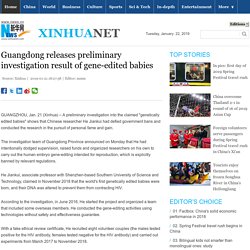
The investigation team of Guangdong Province announced on Monday that He had intentionally dodged supervision, raised funds and organized researchers on his own to carry out the human embryo gene-editing intended for reproduction, which is explicitly banned by relevant regulations. He Jiankui, associate professor with Shenzhen-based Southern University of Science and Technology, claimed in November 2018 that the world's first genetically edited babies were born, and their DNA was altered to prevent them from contracting HIV. According to the investigation, in June 2016, He started the project and organized a team that included some overseas members. Chinese researcher claims first gene-edited babies. HONG KONG (AP) — A Chinese researcher claims that he helped make the world’s first genetically edited babies — twin girls born this month whose DNA he said he altered with a powerful new tool capable of rewriting the very blueprint of life.
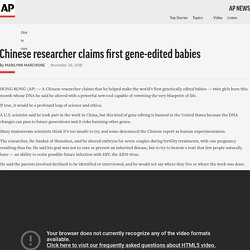
If true, it would be a profound leap of science and ethics. A U.S. scientist said he took part in the work in China, but this kind of gene editing is banned in the United States because the DNA changes can pass to future generations and it risks harming other genes. Many mainstream scientists think it’s too unsafe to try, and some denounced the Chinese report as human experimentation. The researcher, He Jiankui of Shenzhen, said he altered embryos for seven couples during fertility treatments, with one pregnancy resulting thus far. Scientists Wiped Out a Mosquito Population by Hacking Their DNA With CRISPR – Futurism. Brain Cancer's 'Immortality Switch' Turned Off with CRISPR. Many cancer cells can divide indefinitely by flicking on an "immortality switch," a trick most other cell types can't perform.
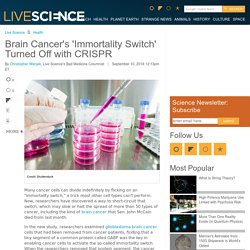
Now, researchers have discovered a way to short-circuit that switch, which may slow or halt the spread of more than 50 types of cancer, including the kind of brain cancer that Sen. John McCain died from last month. In the new study, researchers examined glioblastoma brain cancer cells that had been removed from cancer patients, finding that a tiny segment of a common protein called GABP was the key in enabling cancer cells to activate the so-called immortality switch.
When the researchers removed that protein segment, the cancer cells — both in lab dishes and when transplanted into mice — stopped their voracious multiplying and behaved like mere-mortal cells. [10 Do's and Don'ts to Reduce Your Risk of Cancer] The findings were published today (Sept. 10) in the journal Cancer Cell. A New CRISPR Technique Let Researchers Repair a Genetic Mutation in Viable Human Embryos. IMPROVED ODDS.
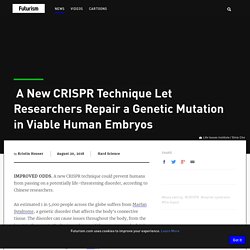
A new CRISPR technique could prevent humans from passing on a potentially life-threatening disorder, according to Chinese researchers. An estimated 1 in 5,000 people across the globe suffers from Marfan Syndrome, a genetic disorder that affects the body’s connective tissue. The disorder can cause issues throughout the body, from the heart to the eyes to the brain, and some of those issues can be fatal.
THE OLD WAY. Typically, CRISPR works a lot like a word processor’s cut and paste function; a researcher can use the tool to target a specific spot in an organism’s genetic code, cut the DNA strands, and either insert a new gene into the gap or let the strands repair themselves. Unfortunately, past research has shown that these cuts to both strands of DNA can produce unwanted edits and potentially even cause cancer. The Chinese researchers didn’t use CRISPR in the typical way, though.
THE BETTER WAY? And it mostly seemed go as planned. Scientists Edit Genetic Diseases Out of Mice Before Birth. Next, Humans. The FDA Puts the Brakes on a Major CRISPR Trial in Humans. You’ve heard it before: CRISPR has the potential to change our lives for the better. But first, we have to give it a chance. In December, gene-editing company CRISPR Therapeutics announced a partnership with biotech company Vertex to develop CTX001, the world’s first gene-based treatment for sickle cell disease (SCD).
At-Home CRISPR Kit Will Diagnose You Better Than WebMD. CRISPR is moving out of the lab and into your home. Mammoth Biosciences, a new biotech company co-founded by CRISPR pioneer Jennifer Doudna, is developing an at-home CRISPR diagnostics kit. If it reaches the commercial market, this kit could replace “Dr. Google” as the average person’s go-to source for health diagnostics. And given how much the internet makes us freak out about our health (usually for no reason), that really can’t happen soon enough. Next-generation diagnostics with CRISPR.
The First "Cell-Free" CRISPR Tech Is Here To Personalize Cancer Treatment. A single technology can help kill superbugs, slow cancer’s growth, and potentially help us end world hunger. No, it’s not magic. Bill Gates on What Gene Editing and CRISPR Means for Public Health and Development. Today, more people are living healthy, productive lives than ever before. This good news may come as a surprise, but there is plenty of evidence for it. Since the early 1990s, global child mortality has been cut in half. There have been massive reductions in cases of tuberculosis, malaria, and HIV/AIDS. The incidence of polio has decreased by 99 percent, bringing the world to the verge of eradicating a major infectious disease, a feat humanity has accomplished only once before, with smallpox. The proportion of the world’s population in extreme poverty, defined by the World Bank as living on less than $1.90 per day, has fallen from 35 percent to about 11 percent.
Continued progress is not inevitable, however, and a great deal of unnecessary suffering and inequity remains. Gizmodo. How CRISPR Works: The Future of Genetic Engineering and Designer Humans. A CRISPR Future: Five Ways Gene Editing Will Transform Our World. A CRISPR Future Over the past few years, CRISPR has been making headlines. Experts predict that this gene editing technology will transform our planet, revolutionizing the societies we live in and the organisms we live alongside. Compared to other tools used for genetic engineering, CRISPR (also known by its more technical name, CRISPR-Cas9) is precise, cheap, easy to use, and remarkably powerful. Discovered in the early 1990s, and first used in biochemical experiments seven years later, CRISPR has rapidly become the most popular gene editing tool among researchers in fields such as human biology, agriculture, and microbiology.
Scientists are still in the earliest stages of figuring out how we can use CRISPR to change the world for the better. 1. Crispr Therapeutics Plans to Launch Its First Clinical Trial in 2018. How Does Crispr Gene Editing Work? Scientists Use CRISPR to Turn E.Coli Bacteria into Microscopic Tape Recorder. In Brief Researchers from the Columbia University Medical Center have used CRISPR to create the world's smallest tape recorder. The recorder is stored inside E.coli bacteria, enabling it to record its interactions with the environment and time-stamp events. CRISPR, Meet E.coli. For the First Time, Scientists Used Gene Editing Inside a Living Patient. In Brief For the first time, scientists have been able to make edits to the human genome inside a living patient. Scientists Establish New Nonviral Method for CRISPR Using Gold Nanoparticles.
In Brief CRISPR's method of delivery has been raised as one limitation of the otherwise revolutionary technology. 33 blood-cancer patients have dramatic clinical remission with new T-cell therapy. Image of a group of killer T cells (green and red) surrounding a cancer cell (blue, center) (credit: NIH) Experts Cast Doubt on Groundbreaking CRISPR Embryo Editing Research. Ten Weird Ways Scientists Are Changing the World With Gene Editing. A New Gene Editing Breakthrough Could Allow Us to Transplant Pig Organs Into Humans. Birth of CRISPR'd pigs advances hopes for turning pigs into organ donors.
Ioengineer Luhan Yang swiped through the photos on her phone until she got to one that made her beam: It showed her crouching down by a pudgy, wide-eyed newborn she calls “my baby.” This newborn is a pig, and it’s the first to be born with dozens of genetic changes that could enable scientists to turn swine into a source of organs for human transplants, Yang and her colleagues reported on Thursday in Science. They named the piglet Laika, after the first dog to orbit Earth in 1957. The new Laika, born this year in China after numerous miscarriages and other setbacks, could be a pioneer in her own right. Nature. Affiliations Department of Genetics, Harvard Medical School, 77 Avenue Louis Pasteur, Boston, Massachusetts 02115, USA Seth L.
Shipman, Jeff Nivala & George M. 11 Incredible Things CRISPR Has Helped Us Achieve in 2017. CRISPR Skin Grafts Could Replace Insulin Shots For Diabetes. How CRISPR Works: The Future of Genetic Engineering and Designer Humans. First U.S. Human Embryo Gene Editing Experiment Successfully "Corrects" a Heart Condition. Deadly gene mutations removed from human embryos in landmark study.
Scientists Upload a Galloping Horse GIF Into Bacteria With Crispr. This New Gene-Editing Technique Can Spot CRISPR’s Mistakes. Gene-Editing Might Relieve Mosquito-Borne Disease. Scientists Modify Viruses with CRISPR to Kill Antibiotic-Resistant Bacteria. 33 blood-cancer patients have dramatic clinical remission with new T-cell therapy. A Controversial Study Is Tearing the CRISPR World Apart.
In Just a Few Short Years, CRISPR Has Sparked a Research Revolution. A World First CRISPR Trial Will Edit Genes Inside the Human Body. Unraveling The Controversy Over The CRISPR Mutations Study. The Promises and Pitfalls of Easy Genetic Modification. Wired. Federal panel approves first use of CRISPR in humans. How Gene Editing Could Ruin Human Evolution. How gene editing is changing the world. New era of 'cut and paste' humans close as man injected with genetically-edited blood
An Era of Super Crops: How CRISPR Could Help Fight Famine. Federal panel approves first use of CRISPR in humans. Cutting Out Cancer: CRISPR Gene Editing Could Make Cancer Mutations Inactive. CRISPR cuts out $90M IPO bid as another gene editing biotech goes public. CRISPR gene-editing method shows promise for agriculture. Chinese Scientists Will Perform First CRISPR Human Gene Editing Trial In August. Scientists call for caution in using DNA-editing technology.
Researchers Use DNA ‘Clews’ to Shuttle CRISPR-Cas9 Gene-Editing Tool into Cells. Do-it-yourself CRISPR genome editing kits bring genetic engineering to your kitchen bench.